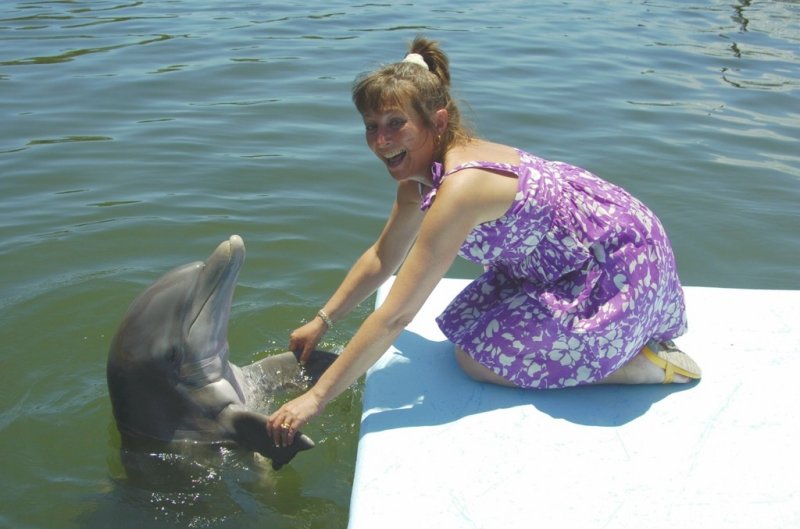The center has 90,000 square feet of lagoons on the Gulf of Mexico. Staff developed a plastic mesh that is used as fencing to keep the center's 19 resident dolphins in and other larger species such as predator sharks out, Stella said. She said occasionally, baby nurse sharks find their way into the lagoons and staff have to rescue them from the dolphins.
The center was home to the five dolphins that shared the lead role in the 1963 hit film "Flipper," and now has several third-generation offspring of the stars. It's also home to Theresa, who is more than 50 years old, a U.S. Navy "employee" until 1968 with a classified background, Stella said. She said the center's staff also assists in manatee rescues but has no permanent facility for them.
The center offers an assortment of "dolphin experiences" for visitors, including 20-minute, waist-deep, in-water visits in which a trainer works the mammals through routines such as a flipper-shakes, flipper-splashing and pairs towing visitors who hold onto dorsal fins.
There are also programs offering daylong courses in training and managing dolphins, marine research and special needs programs for the disabled.
During a recent visit, spectators watching small groups of visitors enter the lagoon area remarked to UPI that "as soon as people see dolphins, they smile." Indeed, the animals appeared healthy and happy and could be seen frolicking on their own without a trainer's instructions. Visitors who touched the dolphins described the feeling as being like "wet hot dogs" or "wet suede."
However, such facilities have their enemies, the biggest being the Humane Society of the United States.
In 1996, Naomi Rose, HSUS marine mammal scientist in Washington told UPI the society "strongly disapproves" of any swim with dolphin programs.
"I'm not denying there's probably therapeutic value to interacting with these animals but there's also therapeutic value in interaction with puppies, kittens, goats and sheep," Rose said.
The society's Web site takes a more aggressive stance against marine facilities.
"Experience has proven that public display does not effectively educate the public and that profit is the main motive for conducting traumatic and stressful captures," the site says.
The DRC's Stella acknowledged the criticism and said there remain some questionable facilities in the United States and elsewhere. She pointed out, however, the center is not-for-profit and quoted the mission statement: "The health and well-being of DRC's dolphins hold absolute precedence over all other interests."
She denied claims that dolphins must perform to be fed, saying the center goes through some 300 pounds of fresh fish each day, with vitamins and antibiotics added when needed.
"We ask dolphins to participate -- we don't force," she said. "The truth of the matter is, you cannot make a dolphin do anything it doesn't choose to do."
Stella said the "Flipper" movie was integral in her personal career choice. The New Jersey native said after seeing the movie as a child, her parents brought her to the center in the 1960s and her passion for dolphins began. She said the 70 largely part-time staff and 20 volunteers often spend far more hours at the site than scheduled, and as with the visitors, UPI observed near-permanent smiles on workers' faces.















